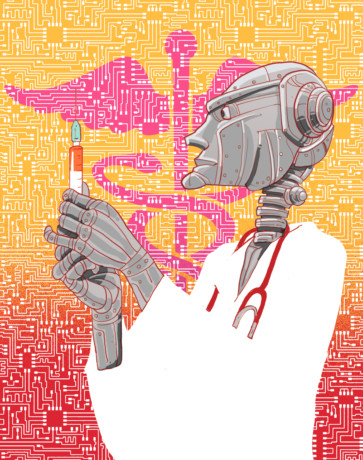
Artificial Intelligence is a popular subject widely being discussed in the technology and business circles. Many industry analysts argue that AI or machine learning is the future — but if we look around, we are convinced that it’s not the future. It is the present.
Artificial intelligence is poised to become a transformational force in health care. It shall make the providers and patients benefit from the impact its AI-driven tools.
This is owing to the situation that the AI is getting increasingly sophisticated at doing what humans do, with higher efficiency and with greater speed and at a lower cost. For example, by deploying AI algorithms to automate administrative tasks — for example in insurance on revenue management cycles — the health care industry could save $18 billion.
On the patients’ side, a clinical trial of an artificial intelligence platform used to coach patients suffering from diabetes observed that 87 per cent of patients who had been using insulin were able either to reduce their insulin usage or stop using with the help of the platform.
Globally, we see about 8.5 million patients annually, and since the biggest strength of AI comes from machine learning, requiring enormous load of data, to come up with complex patterns of micro- and macro-diagnosis and prediction analysis, NMC Healthcare initiated our work in AI about a year ago.
Our projects in AI, now under different stages of maturity and validation via medical universities in the US and Europe, are the following:
* Combining the might of mind and machine via brain-computer interfaces
Neurological disorders and trauma to the nervous system can compromise a patient’s abilities to speak, move, and interact. With brain-computer interfaces (BCIs) backed by artificial intelligence, we can restore some of the fundamental experiences to those who feared them as lost forever. Brain-computer interfaces could drastically improve quality of life for patients with stroke, as well as the 500,000 people worldwide who experience spinal cord injuries every year.
* The gen-next radiology tools
The radiological scans obtained by MRI machines, CAT scanners, and X-rays offer non-invasive visibility into the inner workings of the human body. However, many diagnostic processes still rely on physical tissue samples obtained through biopsies, which carry risks including the potential for infection.
Artificial intelligence will enable the next generation of radiology tools that are accurate and detailed enough to replace the need for tissue samples in most cases, and it would be like bringing together the surgeon, interventional radiologist and the pathologist.
* Enhancing access to care in underserved geographies Shortage of trained health care providers, including ultrasound technicians and radiologists, can significantly limit access to life-saving care in developing nations. AI imaging tools can screen chest X-rays for signs of tuberculosis, often achieving a level of accuracy comparable to humans. There is a caveat though — developers of the AI tools must be careful to account for disparate ethnic groups as it becomes imperative to make sure that the data represents a diversity of disease presentations and populations.
* The burden of electronic health records
EHRs have played an instrumental role in the health care industry’s journey towards digitalisation, but the switch has brought myriad problems associated with cognitive overload, endless documentation, and user burnout. We did a pilot on this with du as the UAE embarked upon an ambitious plan to use blockchain and digitise all records.
Now clinicians, who spend a majority of their time on three tasks — clinical documentation, diagnostic orders entry, and sorting through the in-basket of results — would be able to spare that time for a personal touch to their patients.
Generating precise analytics for pathology images Our pathologists provide one of the most significant sources of diagnostic data for providers across the continuum of care delivery models. Given that 70 per cent of all decisions in health care are based on pathology results — and somewhere between the same percentage of all the data in an EHR are from pathology results — the more accurate we get, the sooner we get to the right diagnosis and the better we’re going to be. That’s what digital pathology and AI hold the promise to deliver.
* Bringing intelligence to medical devices and machines In the medical environment, smart devices are critical for monitoring patients in the ICU and elsewhere. Using artificial intelligence to enhance the ability to identify deterioration, or sense the development of complications can significantly improve outcomes and reduce costs related to hospital-acquired condition penalties.
Prasanth Manghat is CEO and Executive Director at NMC Health plc.












